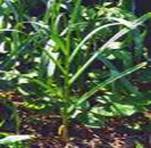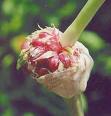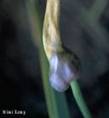| Kingdom | Plantae |
| Order | Asparagales |
| Family | Alliaceae |
| Genus | Allium |
| Species | A. sativum |
| Binomial name | Allium sativum |
Other Common Names:
The other common names for the herb garlic are Clove Garlic, a Suan, and Poor-man's-treacle, Rashona, Rustic's Treacle, Stinking Rose and Tricolour Garlic.
History
The name is of Anglo-Saxon origin, being derived from gar (a spear) and lac (a plant), in reference to the shape of its leaves. This was anciently accounted the poor man's treacle, it being a remedy for all diseases and hurts. The Garlic bulb is a member of the Onion family with Chives, Leeks and Shallots. Garlic is mentioned in several Old English vocabularies of plants from the tenth to fifteenth centuries, and is described by the herbalists of the sixteenth century from Turner (1548) onwards. It is widely cultivated in the Latin countries bordering on the Mediterranean.

Description
Allium sativum is a perennial that can grow 2 feet high or more. The Garlic plant has 6-12 long, narrow and flat like grass leaves. The most important part of this plant for medicinal purposes is the bulb. The bulb consists of numerous bulblets, known as 'cloves' held between the papery membranes and enclosed within a whitish skin as a sac. Each bulb is made up of 4 to 20 cloves, and each clove weighs about 1 gram. The flowers rise direct from the bulb and are white in color.


The flowers are small and white, and make their appearance in July. The bulbs, or so-called cloves, are usually six or eight in number, oblong or wedge-shaped, and covered with dry membranous scales, with a pungent odour and a disagreeable and acrid taste.
Range
Garlic is cultivated everywhere, but originates in India or central Asia. This species of garlic grows wild in Sicily, Italy, and the south of France. The garlic grows rather well in most places in the continental United States and is much naturalized in this country.
Habitat
The garlic plant grows optimally in rich and well drained soils, possessing high amounts of organic compounds. At the same time, it is also possible to successfully grow the garlic in a wide range of soil varieties and climatic conditions. The garlic tolerates a pH range from slightly acidic 5.5 to an alkaline 8.5 - growing optimally within these extremes. The garlic grows optimally in sites that have good exposure to sunlight; however, it can also grow successfully at sites with a partial shade.
Cultivation
Garlic can be grown from the cloves or the bulbils as most garden grown garlic will not produce seeds. Garlic cloves are usually planted in seedbeds early in the spring or late in the fall. Garlic planted in the fall tends to result in the best yields. This is mainly due to the fact, that the garlic plant requires a rather long growing season of a minimum of four months to grow to an optimal size. Garlic plants planted in the soil late in the month of September or in October can be expect to show their growing tops emerging from the soil by the month of November - by winter, all the plants will have rooted well at the site. Tender garlic plants have cloves that remain dormant over the winter; these will only resume growth in the spring when the snow melts. For optimum growth later and to successfully form new bulbs, the dormant cloves or young plants require some exposure to cold temperatures ranging from 0°C to 10°C - 32°F to 50°F - for a period of four to eight weeks. The dormancy of garlic plants is broken by the increasing daylight hours during the spring. This also leads to the stimulation of the plants and encourages bulb formation in the plants. Garlic cloves must be planted into the soil with the pointed end up towards the surface. A planting depth of five cm - two inches - below the soil's surface is ideal for optimum growth. Each individual clove must be planted a minimum of eight cm -three inches - deep in the soil. Garlic plants require some space from neighbouring plants to grow well, plant the cloves leaving a space of fifteen cm - six inches - around each clove to give the seedling some room. It is important to tend growing garlic plants with care, as strong movement of the soil around the shallow rooted garlic plants will result in damage to the roots and hence retard the development of such plants. In mid-summer, it becomes necessary to cut back the flowering stalks on the plants, this helps in channelling all the plant's energy into the development of storage bulbs resulting in a good yield. The garlic is normally free of pests and common plant diseases - it is a hardy herb compared to many other cultivated plants. When growing garlic, in the northernmost range, it becomes necessary to mulch the cloves or young plants over the winter particularly if the snow cover in the area is limited.
Parts Used

The bulb and the cloves of the garlic are the most commonly used parts of the plant mainly for its medicinal and commercial purposes.
Flowering Season
The flowers placed at the end of a stalk rising direct from the bulb which are whitish are in bloom in the summers.
Pests and Diseases
Garlic plants are not attacked by pests. They can suffer from pink root, a disease that stunts the roots and turns them pink or red.
Medicinal Applications


• It provokes urine and women's courses, helps the biting of mad dogs, and other venomous creatures; kills the worms in children, cuts and voids tough phlegm, purges the head, helps the lethargy, is a good preservative against, and a remedy for, any plague, sore or foul ulcer.
• It takes away spots and blemishes in the skin, ceases pains in the scars, and ripens and breaks imposthumes or other swellings.
• Garlic is also good in hydropic diseases, jaundice, falling-sickness, cramps, convulsions, piles or other cold diseases.
• The juice made into syrup is given for coughs, colds and asthma, because of its expectorant properties.
• It is sometimes externally applied in ointments and lotions, and as an antiseptic, to disperse hard swellings, also pounded and employed as a poultice for scrofulous sores. It is said to prevent anthrax in cattle, being largely used for the purpose.
• In olden days, Garlic was employed as a specific for leprosy. It was also believed that it had most beneficial results in cases of smallpox, if cut small and applied to the soles of the feet in a linen cloth, renewed daily.
• Syrup of Garlic is an invaluable medicine for asthma, hoarseness, coughs, difficulty of breathing, and most other disorders of the lungs,
• An infusion of the bruised bulbs, given before and after every meal, has been considered of good effect in epilepsy.
• A clove or two of Garlic, pounded with honey and taken two or three nights successively, is good in rheumatism.
• The remedies made from the garlic are also effective and potent for treating intestinal worms as well as problems such as candidiasis.
• Garlic remedies can also be used topically to treat thrush affecting the mouth or the vaginal cavity. The general rate of digestion is improved by garlic; the herb also helps alleviate excessive gas and abdominal distension in the body.
• Garlic is also a good remedy for blood sugar related problems in diabetics as the herb boosts the secretion of insulin in the pancreas - thus helping the body better regulate sugar levels.
• The remedy made from the garlic also has a decongestant action and is very useful in treating problems affecting the respiratory passages.
• Fevers can be alleviated by consuming garlic - the herb induces perspiration in the body and this helps in lowering the elevated body temperature.
• The elevated blood pressure in the body and the tendency to form clots is also lowered by garlic - this effect of the herb is helpful in the prevention of heart attacks and strokes in susceptible patients.
• The blood vessels in the body are also opened up and dilated by the action of garlic - this action results in an increase in the flow of blood to different tissues in the body, thereby improving the general circulation.
Commercial Applications

• Garlic used in the preparation of food may be fresh, dried, or freshly ground.
• Garlic helps in increasing the flavour of all kinds of dishes including seafood, poultry preparations, various pasta items, and all kinds of meat dishes, vegetables and meat stews.
• It can be added to casseroles, vegetables, and soups; it brings zest to salads and salad dressings.

Garlic was placed by the ancient Greeks (Theophrastus relates) on the piles of stones at cross-roads as a supper for Hecate, and according to Pliny garlic and onion were invocated as deities by the Egyptians at the taking of oaths. Among the ancient Greeks, persons who partook of it were not allowed to enter the temples of Cybele.Garlic has been regarded as a force for both good and evil.
A Christian myth considers that after Satan left the Garden of Eden, garlic arose in his left footprint, and onion in the right. In Europe, many cultures have used garlic for protection or white magic, perhaps owing to its reputation as a potent preventative medicine. Central European folk beliefs considered garlic a powerful ward against demons, werewolves, and vampires. To ward off vampires, garlic could be worn, hung in windows or rubbed on chimneys and keyholes. In Taoism mythology, six clove black garlic is used as part of the process of modifying a Taoist's genetics. The association of garlic to evil spirits may be based on the antibacterial, ant parasitic value of garlic, which could prevent infections that lead to delusions, and other related mental illness symptoms.
Garlic is called "lassan" in Hindi and related Sanskrit-based languages such as Gujarati. In both Hinduism and Jainism, garlic is considered to stimulate and warm the body and to increase one's desires. Hindus generally avoid using garlic and the related onion in the preparation of foods for religious festivities and events. Followers of the Jain religion avoid eating garlic and onion on a daily basis. In connection with the odour associated with garlic, Islam views eating garlic and subsequently going to the mosque as inappropriate. "Whoever has eaten (garlic) should not approach our mosque," indicated Muhammad.
There is a curious superstition in some parts of Europe, that if a morsel of the bulb be chewed by a man running a race it will prevent his competitors from getting ahead of him, and Hungarian jockeys will sometimes fasten a clove of Garlic to the bits of their horses in the belief that any other racers running close to those thus baited, will fall back the instant they smell the offensive odour. The magical use of GARLIC to ward off evil derives from European witchcraft but has made considerable inroads into the African-American community.
As a Protective Plant, garlic is an ingredient in Four Thieves Vinegar and is added to scrub water when spiritually cleansing a building to rid it of evil or to keep the law away. Hang a braid of garlic in the kitchen to discourage troublesome visitors; use it as needed for cooking, and replace it every year. It is said that evil people put liver things in an enemy by shaking a rattlesnake rattle in the water which the victim will drink, causing Live Things such as Snakes to grow in the stomach.